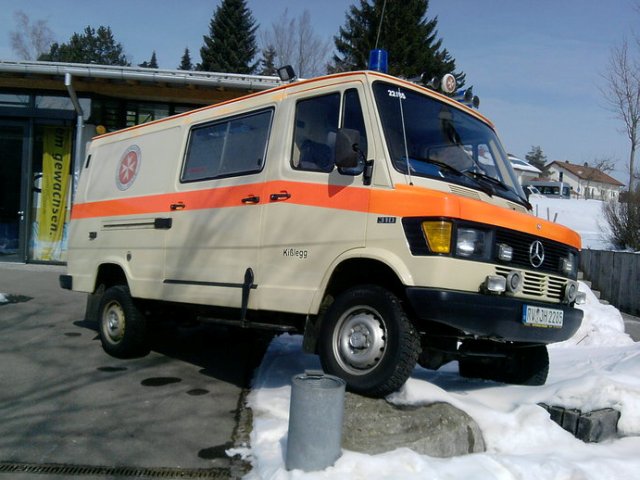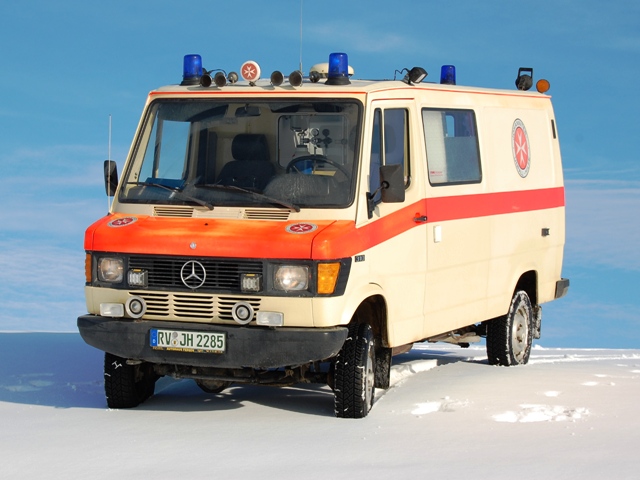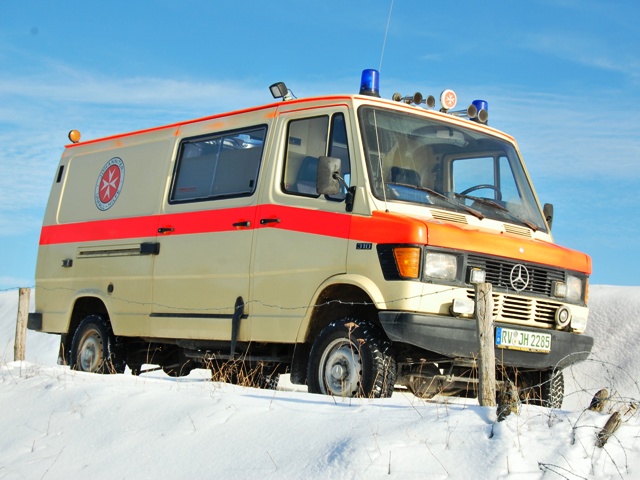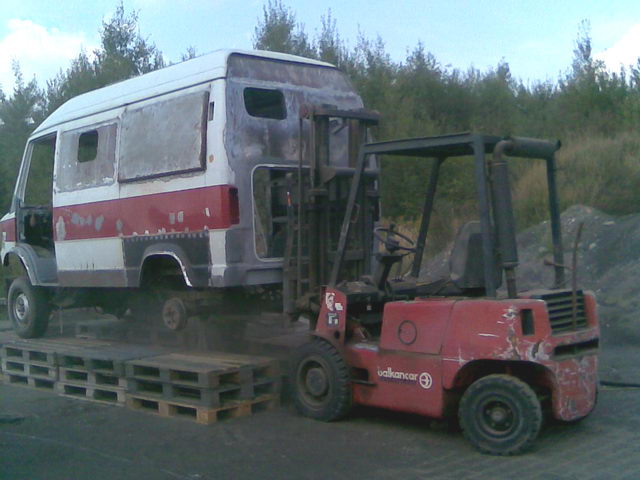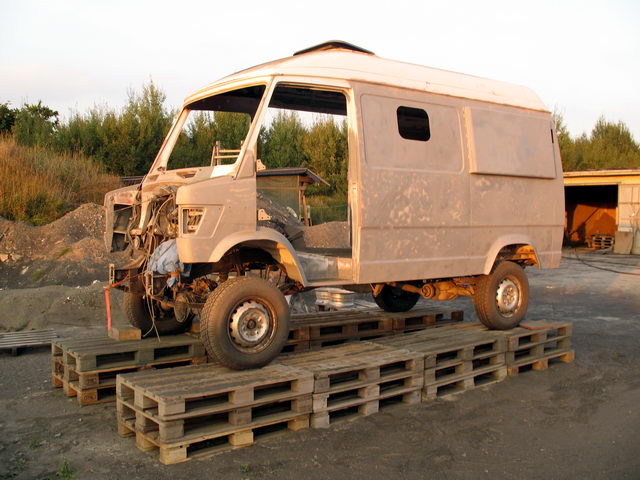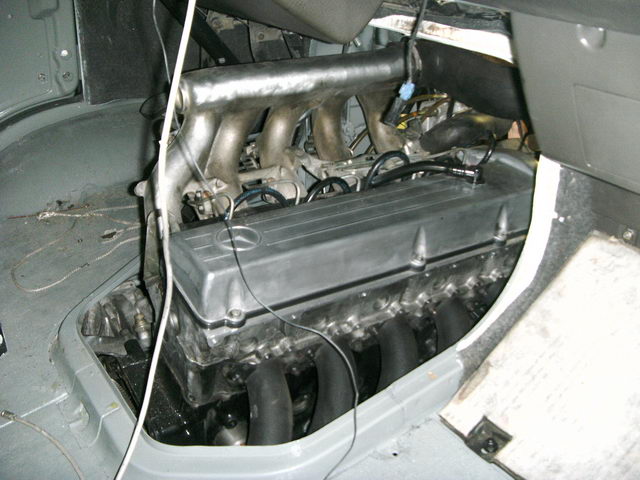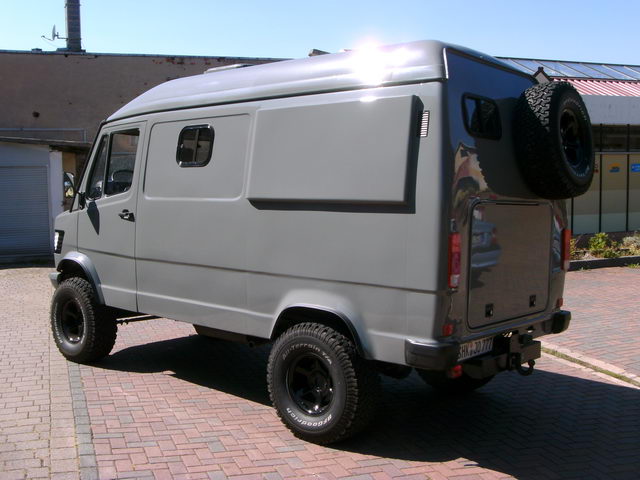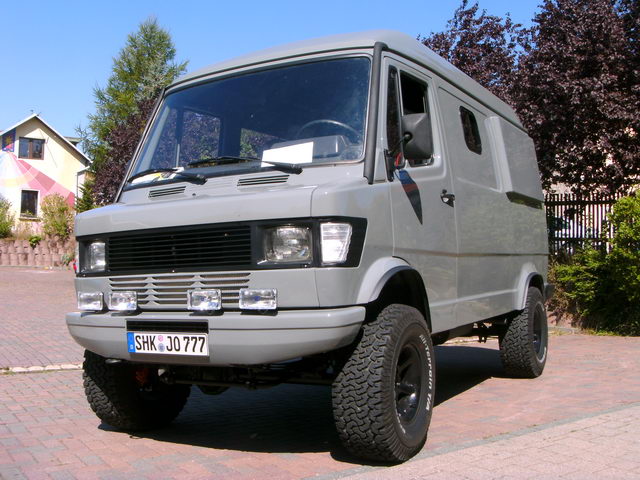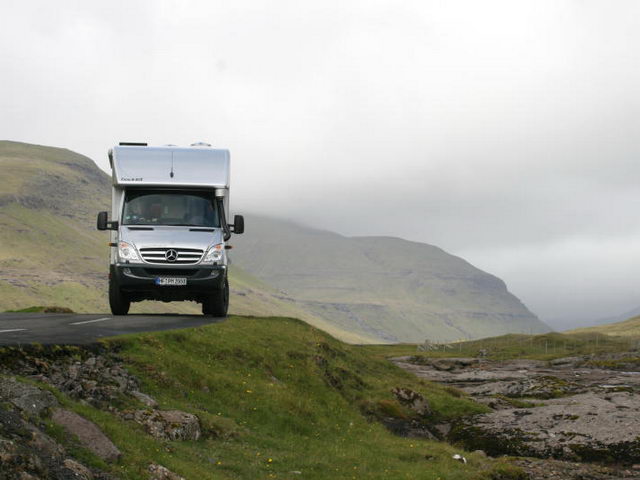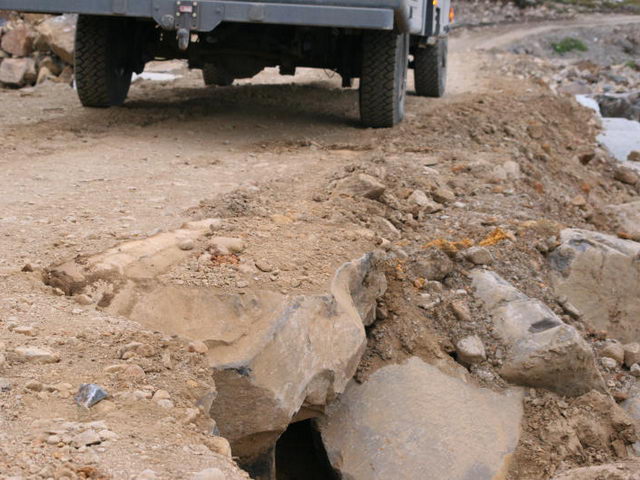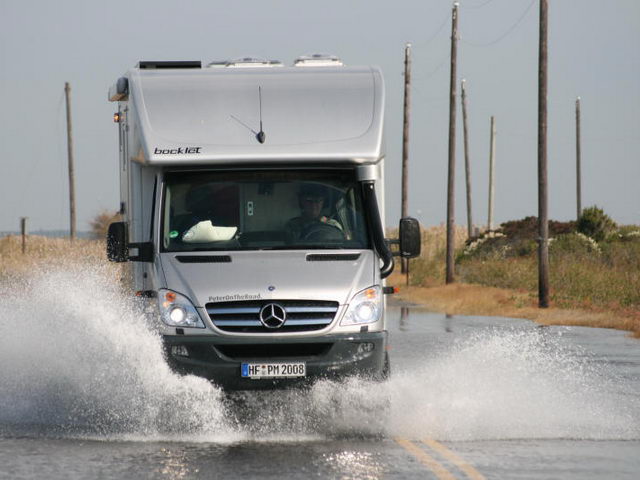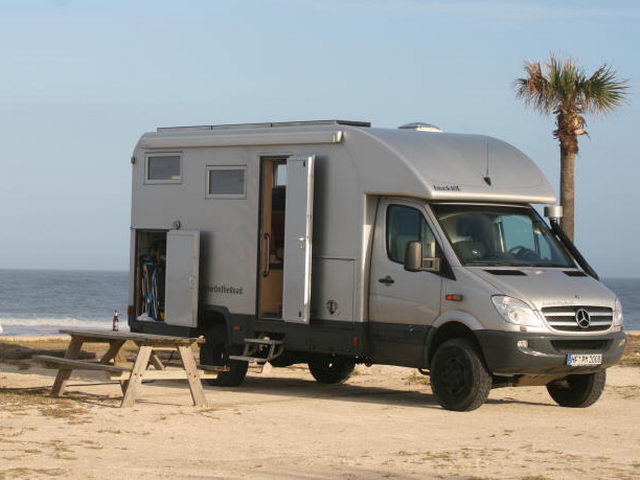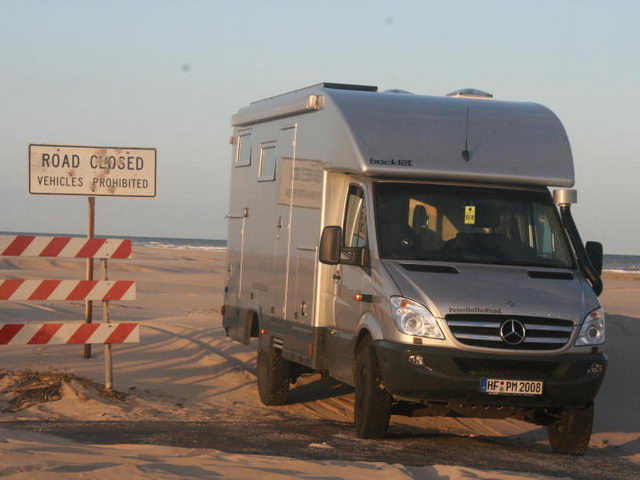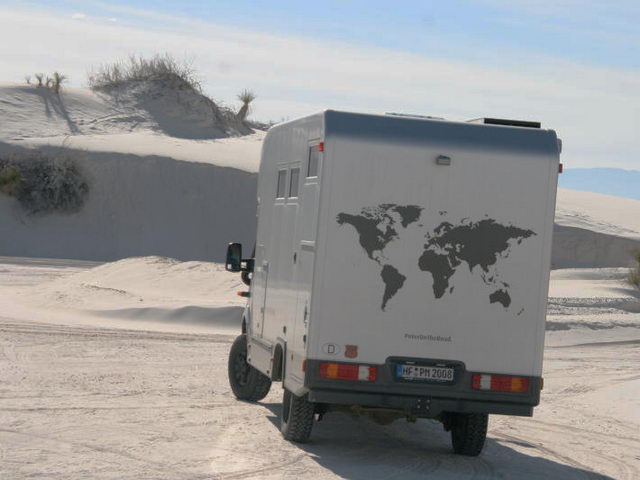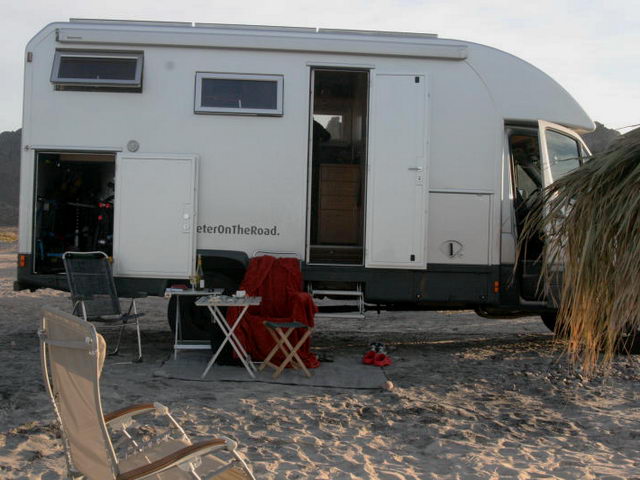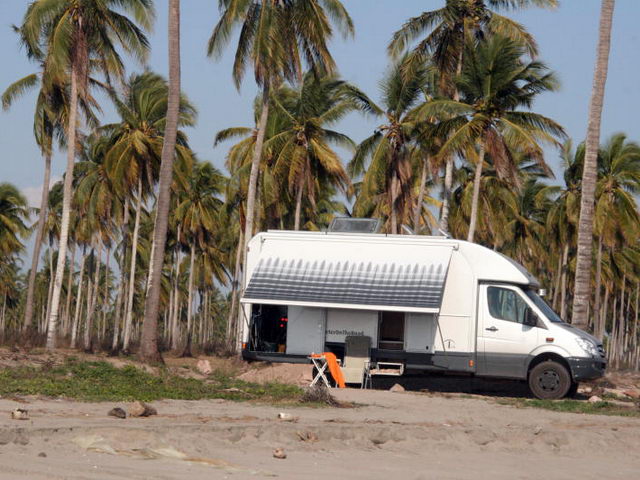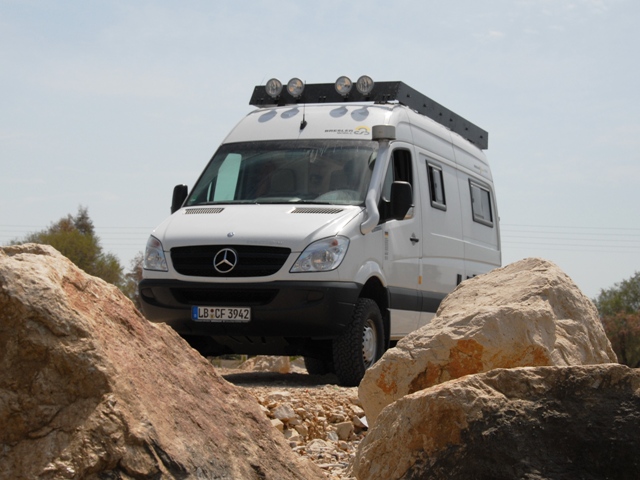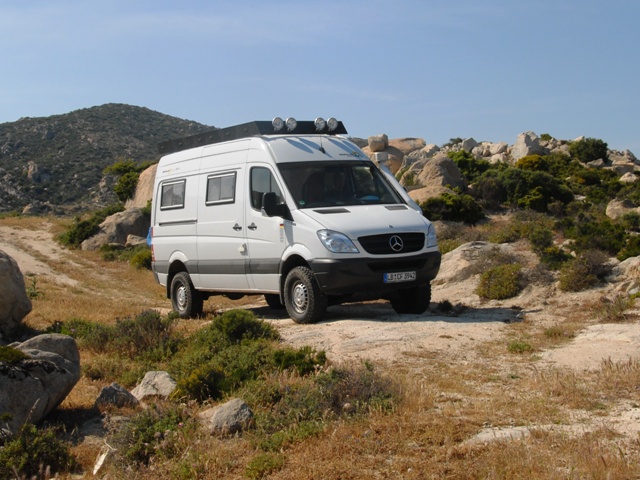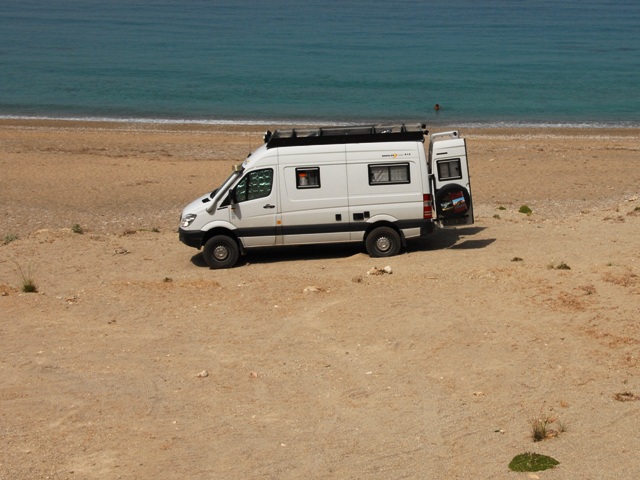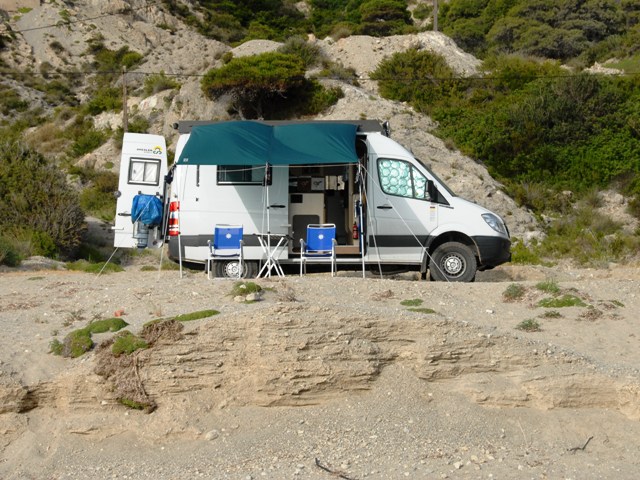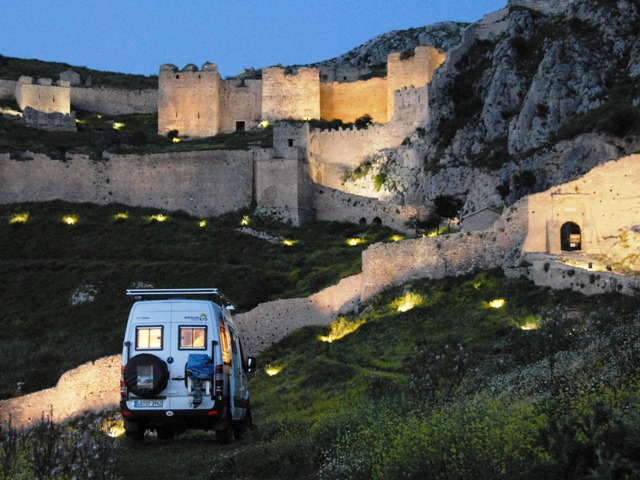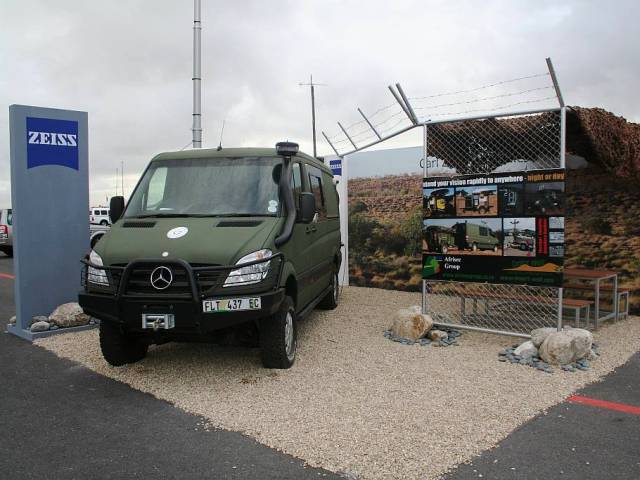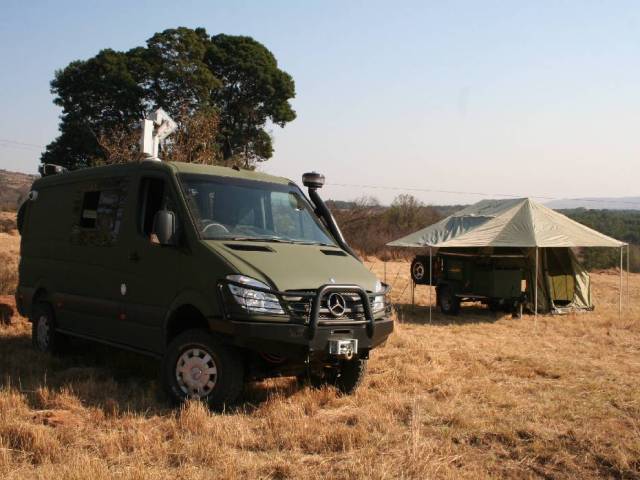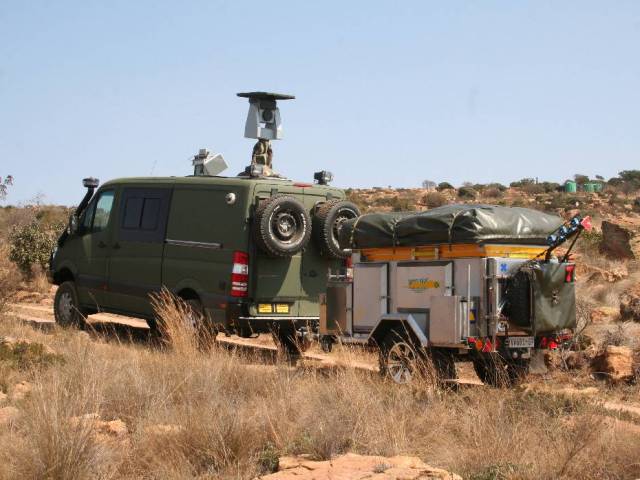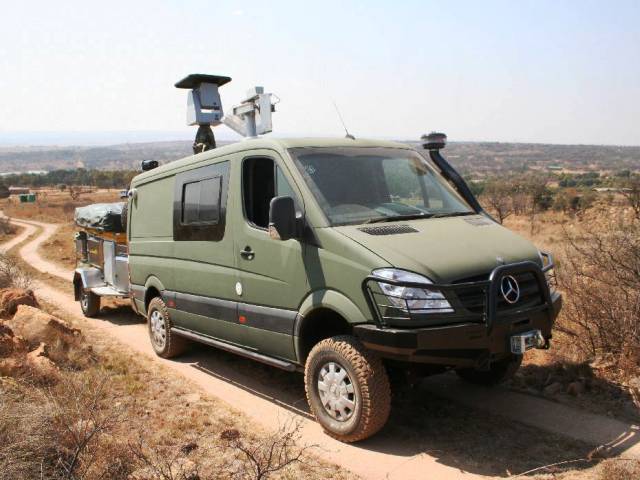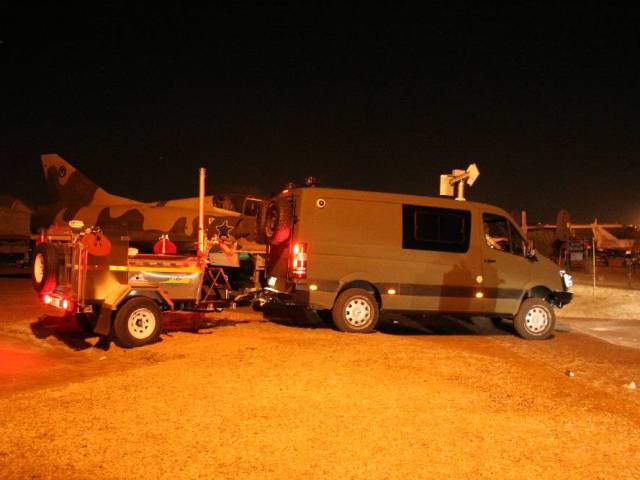"Johanniter-Unfall-Hilfe", Kisslegg
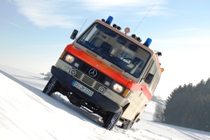
The following report comes from Upper Swabia, specifically the region around Lake Constance. Mr Suffa reports with great enthusiasm:
"This vehicle was the fifth ambulance to leave the factory of Strobel company in Aalen. It was delivered to the Johanniter-Unfall-Hilfe in Singen in 1986, where it served loyally for many years until it was put out of service in 2004. The Johanniter-Bereitschaft Singen then converted it into an equipment car to transport technical aids, devices and tents for ambulance duties.
In the summer of 2009, the vehicle was sold to the Johanniter-Bereitschaft Kißlegg in the scope of savings measures. They spent several months carefully restoring the old "Iglhaut" to return it to ambulance duties.
It is now again serving well as a KTW (Kranken Transport Wagen; patient transport ambulance), e.g. in ambulance duty or as a background patient transport or regular ambulance. Where regular rescue equipment cannot proceed, e.g. during snowstorms in winter or when recovering injured persons from hard terrain, it is still running very well.
The "Bereitschaft Kißlegg" is proud of its highly successful Iglhaut patient transport ambulance. Their hard work was rewarded during ambulance duty on the Southside-Festival in 2010 at the latest. After several days of continuing rain, the entire event premises were covered in 20 - 30 cm of deep sludge. By then, only the "Iglhaut" could get through. No one was surprised that the Kißleggers had by far the most deployments that weekend – a great source of pride for the volunteers. It even makes them less sad about the consumption of approx. 25 litres of Super Plus
The Kißleggers would like to thank their duty manager Robert Lohr, who made it possible to purchase and restore this vehicle with financial support and by providing his workshop."
We would like to thank Mr Suffa and the volunteers from Kißlegg for this nice report and wish that Johanniters that will "rock" ambulance duty with their "Iglhaut" for many years to come!!
Technical data:
- Mercedes-Benz 310 petrol
- IGLHAUT all-wheel
- Year of build 1986
- All-wheel conversion 1986
- 50,000 km
- 70 kW (95 PS)
- Tyres (current) 205/75 R16
"Everything was removed."
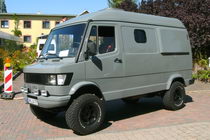
Mr Volkland put every free minute into restoring his T1 all-wheel vehicle for three years.
Mr Volkland, from the Jena area, must be a true fan of IGLHAUT all-wheel vehicles. For more than 3 years, he put every free minute into restoring a Mercedes-Benz T1 built in 1991. He had first seen the vehicle 2 years before. At the time, it was owned by a seller of roasted chicken from Jena who had bought the van in 1991 and had it converted into an all-wheel transported by IGLHAUT in 1995. The chicken seller wasn't willing to sell in spite of the bad condition of the vehicle, however, since he had just invested in a fresh TÜV acceptance.
Mr Volkland stuck with his 309 D for the time being – which didn't have an all-wheel drive. He had to "dig it out" often when taking trips and travelling across loose ground, on the field around the corner, on the beach in Denmark and in the Western Sahara. His wish for a T1 all-wheel vehicle grew increasingly urgent.
His dream finally came true in July of 2006! The chicken vendor gave in and sold his all-wheel vehicle to Mr Volkland in spite of the many "applicants".
Restoration and conversion started immediately. The tail was welded shut and 5 cm wide extensions were applied into the rear window openings to make for an inner width of 195 cm. The spare wheel holder in the rear is supported by a specifically-integrated auxiliary frame. The wheel runs were pulled outward by 4 cm and widened further with a rubber lip. Everything else made of any kind of metal had to be repaired: sills, wheel runs, cowl, frame, entrances, wheel cases, mudguards, doors and the load compartment bottom - virtually the entire car body had been strongly marked by corrosion and needed to be repaired and sealed. The entire vehicle was sandblasted, half of it primed with zinc dust and given an entirely new coat of paint. It was given a roof hatch from an Atego and sliding windows from the Bundeswehr. The inside of the van was completely insulated. The technical pieces were also completely overhauled. Motor, gear, articulated shafts, track rods – everything was removed, revised and repainted.
Interior development is to start this winter. The plans include a compressor fridge, solar system, triple-flame cooker, hot-water boiler, 130-litre fresh-water tank and a 70-litre additional diesel tank, auxiliary heating, electrical footboard and others.
Mr Volkland is self-taught where his knowledge of T1 technology is concerned. He has put far in excess of 1,000 working hours into its restoration to date, as well as lots of money! He now probably has one of the best Mercedes-Benz T1 that are still in existence – and one of the very last all-wheel T1 IGLHAUTs!
We would like to congratulate Mr Volkland on his performance and this wonderful bus. We wish him lots of fun in his future excursions. He has already planned various trips to Northern Europe, Africa, Eastern Europe and, at some point, South America!
Technical Data:
- Mercedes-Benz 310 D
- IGLHAUT all-wheel
- Differential lock rear
- Year of build 1991, All-wheel conversion 1995
- 160,000 km
- Tyres 33x12.5" BFGoodrich AllTerrain on light-metal wheel 8x15"
PeterOnTheRoad.

Everyone has a personal dream for his life.
Mr Mersmann puts his into practice with his all-wheel caravan that he lovingly calls the "Pierremobil".
Whenever he brings his impressive vehicle to us for inspection, we are full of envy to see where he has been in the meantime:
The rear of his expedition mobile has a huge map of the world, decorated with coloured dots that mark the stations of his travels. They grow more and more...
The travels of Mr Mersmann can be seen online at www.peterontheroad.com.
With a cold box, toilet and camera: cfb - in - motion
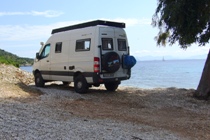
Mr Böttger records his experience with caravans, and of course also his experience with IGLHAUT all-wheel caravans, in his books:
Mit Kühlbox, Klo und Kamera: Vergnügliches und Nützliches aus über 40 Jahren im Reisemobil" and "Südafrika im Reisemobil: Entdecker-Touren durch das faszinierende Land der Regenbogen-Nation".
Follow Mr Böttger's activities online at www.cfb-in-motion.com.
Mr Böttger has provided us with a small excerpt from "Mit Kühlbox, Klo und Kamera..."..
Have fun reading!
Between vines and sheds.
The idea is as simple as it is ingenious. Nevertheless, or maybe specifically because of this, it was put into practice in France rather than in Germany. It happened like this: Pierre Ginoux, the editor of a specialist magazine for winegrowers in Carpentras in Provence, was always travelling the vineyards of his readers with his motorhome. He always found generous parking places of the kind he would have liked for his holidays as well. On one such tour, he had a great idea: winegrowers have lots of space. They are always looking for customers. Motor home users are looking for peaceful parking places in a nice landscape and are often looking for a good bottle of wine. All you need to do is bring the two groups together. That would be a win-win situation.
It wasn't quite that simple. There were a few laws in the way of putting his idea into practice – in this case the rules for the hospitality business. Hard as it is to believe, but at times even the people of Southern France will subject to bureaucracy. In contrast to other peoples, they seem to continually think about how to legally circumvent laws. Ginoux did the same, until he finally had a brilliant idea: invitation. If the winegrowers were to personally invite the motorhome travellers, the laws about the hotel business would not apply. The motorhome travellers would come in as private guests, would be allowed to spend the night for free but would surely in return to participate in a wine tasting and buy a bottle or two for their further travels. France Passion had been born.
At first, only the winegrowers from Provence joined the network. Later, Ginoux spread his system across France, finally also including farms. In spite of this immense expansion, France Passion hasn't changed at heart. A motorhome traveller can purchase a brochure that lists all the participating vineyards and farms with their address, instructions on how to find them and a short description of the parking places. The last kilometre before the vineyards is usually marked with France-Passion arrows. Once there, he shows his personal guest card and a car sticker. That's it.
We first took a tour through the vineyards of France Passion in 1994 – the second year of its existence. To start out, we had a memorable interview with founder Pierre Ginoux in Carpentras. Then we visited many different vineyards in Provence, Bourgogne and in Alsace, which gave us memorable experiences. The proximity to the owners was particularly fascinating to us.
At times, it was incredible; we were usually welcomed and taken in like old friends. Our craziest experience happened on a small vineyard near Besançon. We had just parked our motorhome between trees at the edge of the property and were going to just introduce ourselves and register. Before we realised what was happening, we were sitting in the middle of a birthday party. The owner was celebrating his sixtieth birthday and had invited his extended family. After a great welcome, we ended up between a sister from Lyon and a grandson from Paris and were heaped with food and wine. It was to be a long night in this merry round.
Something entirely different happened a few days later in the area around Orange and Mont Ventoux. We spent the night on a huge gravel-covered parking place in front of an impressive, awe-inspiring Château that would have easily offered space for ten travelling buses. Judging by the sizes and elegance of the modern glass sales pavilions, they probably also brought their freight here for a wine tasting every day during the main travelling season.
We will remember another vineyard in the region for its narrow entrance between two columns with stone lion's heads and its owners, who were nobility. When we were trying to take a picture of the two and their fine greyhounds on the open stairwell at least twenty metres in width, I had to place them very carefully to keep the thirty-centimetre-tall weeds growing between the stone plates out of the picture.
Young, dedicated, the lady wearing jeans and a headscarf, another winegrowers' couple showed us their small vineyard that night and invited us to a wine tasting in an attachment to their house that was hardly larger than a double garage. That was a single exception, though. Most vineyards covered immense areas, had long drives between the gate and buildings, and offered generous parking areas. Once, we almost stood between the vines, another time we were next to the tool shed, then again right next to the Château.
Sometimes, we were offered electrical power or allowed to use the vineyard's washrooms and toilets. At all times, we experienced disarming cordiality and hospitality. Usually, we weren't only shown the vineyards, the estate and the cellar, but even the private rooms in the Châteaus, even if we did not accept the offer for taking wine, sometimes in connection with a dinner. It was also very nice that no one tried to pressure us to buy wine. Nevertheless, we bought between three and six bottles at every stay and put them in the shower. We won't tell how long it took us to drink them all.
A vineyard near Montpellier impressed us most during this tour. Its cellar wasn't, as usual, underground. Its huge oak casks were placed in the side aisles of a Gothic cathedral that looked like it could have easily stood in Avignon or Strasbourg as well if going by appearance and size.
It was incredible, hardly imaginable. We drive across natural tracks, through trees, bushes and reeds from the vineyard to a peninsula. And there it suddenly was, this huge building with a dense forest growing around it. The vintner opened the four-metre-high portal with a medieval key the size of a man's hand, opened the groaning door, and we entered this incredibly high cathedral. Pale light was falling through the altar window in rays as the great painters have drawn them when depicting the resurrection of Christ. This light was falling into an entirely empty cathedral, though. There was nothing: no altar, no pulpit, no benches, no church pews, no mosaic floors - nothing.
We didn't see them until we walked, awe-struck, across the dusty, beaten-down clay floor to the side aisles. Step by step, the outlines of the wine casks, up to six metres high, appeared out of the gloom in front of the side-aisle windows that had been painted shut.
And suddenly, the vintner's voice brought us out of this wonderful, grotesque and fascinating mood. We were still somewhat absent-minded when listening to the sober and busy explanations of growing wine in general and the specialties of this Château in particular.
The Super-Van "The Green Hulk”.

Here comes a press release, with the friendly permission of Carl Zeiss Optics GmbH:
We would like to add that this vehicle is a Mercedes-Benz sprinter with IGLHAUT all-wheel drive, 3 mechanical differential locks, undertray protection and other equipment details added specifically for South Africa.
The Super-Van "The Green Hulk"
The first mobile surveillance vehicles have been delivered to the Nelson Mandela Bay Municipality. They are called "Green Hulk" or "Spy Van": This green monster is a true eye-catcher. The powerful van is the first mobile surveillance vehicle (MSV) built in South Africa. In cooperation with Afrisec, a supplier for integrated security systems, Carl Zeiss Optronics (South Africa) presented the MSV to a number of potential purchasers in summer. The MSV, built on the chassis of a 4 x 4 Mercedes Sprinter, provides 360° all-round surveillance day and night. "We hope that the MSV will soon play an important role in securing borders and fighting crime," project manager Albert du Toit from Carl Zeiss Optronics explains. To find criminals and intruders, the vehicle has been equipped with integrated sensors, a CCD camera with 12-fold enlargement for daylight operation, a high-resolution heat image camera for the night, an eye-safe laser distance meter, a digital magnetic compass and a GPS.
The sensors are placed on an extensible mast that is controlled from the inner space. The observers in the vehicle not only see the video material, but also a digital picture of the environment. For this, all data and targets are shown on a digital map. Software that automatically recognises intruder movement is used to relieve the operators. The video material can also be sent to a control room from the surveillance position. For covert investigations, the vehicle can be moved to strategic places at night with the headlights off thanks to a diver's night vision device. Afrisec will deliver the first vehicle to the Nelson Mandela Bay Municipality to support the region in its fight against crime. Further orders from other towns in South Africa are expected. To date, ZEO has delivered 250 surveillance vehicles that are used to control the European borders.
Jaco Olivier
"Geländeretter". All-terrain rescuers.

The medical services of Fraport AG put a highly off-road-capable ambulance into service in Germany. This quite unique vehicle has been specifically designed for rescue missions on construction sites and when searching for crashed aircraft.
For this purpose, the Mercedes-Benz sprinter has an off-road gear reduction, three differential locks and special tyres. It is also equipped with 14 search and working headlights that will light an area of up to 100 metres well in pitch-darkness. Its medical equipment corresponds to that of a regular ambulance. On demand, municipalities in the area of the airport may request the vehicle via the emergency number of the safety control centre.
The ambulance is manned by trained staff from the rescue service. Similar vehicles are only found in coastal regions for rescue duty at the beach.
Rhein-Main TV presents the new off-road ambulance (starting approx. at minute 2:40):


